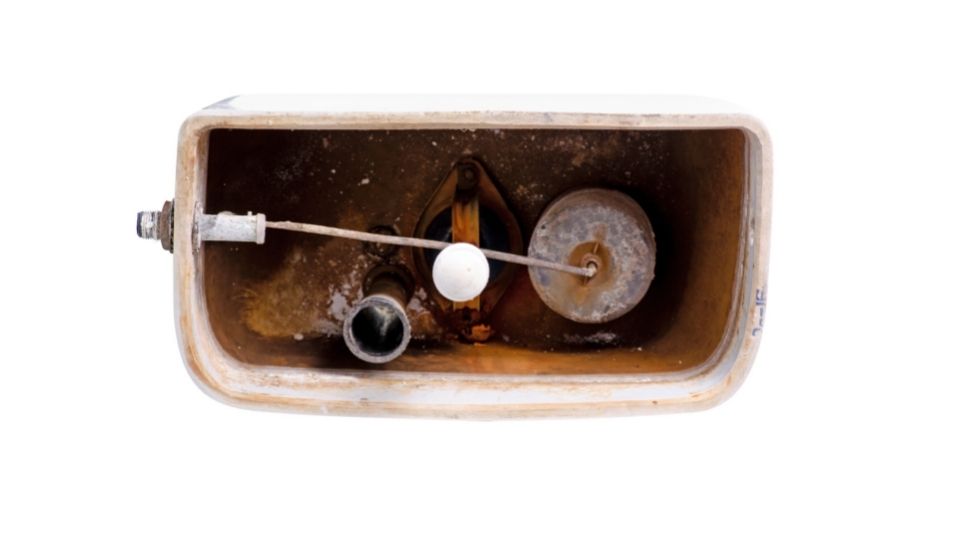This is a question we all face at one time or another, and the answer usually isn’t that simple. There are many more factors involved in this process than you might think. To get to the bottom of things, let’s take a closer look at what causes brown stains in a toilet bowl and how they form. let’s take a look at the possible things that cause brown stains in the toilet bowl.
Brown Stains in Toilet Bowl Common Causes
1. Lime Build up:
Calcium and lime deposits tend to build up around the base of a toilet bowl and can sometimes work their way up along the inside of the bowl and present themselves as brown stains. There is also a chance of lime deposits on the top surface of a toilet bowl.
Lime build-up is not as common as some other causes, but you should be aware that this is indeed one of those causes that lead to those brown stains. To eliminate this problem you can use vinegar or bleach solution to clean your toilet bowl.
2. Hard water:
Hard water is water that has high mineral content. Water that contains large amounts of minerals tends to leave deposits in the toilet bowl. These deposits can lead to brown stains if left unattended for a long time. To eliminate this problem you should use soft water or install a system that turns hard water into soft water before using it inside the house.
3. Rust:
Rust is caused when there is a sudden change in temperature, for example when hot and cold water mixes together inside the pipes. In these cases, you should let the water to cool down before use, otherwise, you will find brown rust stains in your toilet bowl.
4. Iron compounds:
Iron is a heavy metal and when it mixes with water it forms a brown iron oxide that can settle at the bottom of a toilet bowl and then cause brownish stains in your toilet bowl.
The usual way this happens is when people have hard water inside their house and therefore have a lot of deposits in the tank because of the minerals contained in the hard water.
5. Germs and Bacteria:
Germs and bacteria thrive in moist and wet conditions. Large amounts of germs and bacteria will lead to brown staining in your toilet bowl. The most common causes of this are when people do not flush the toilet after using it, the tissue they throw into it, or urine stains that are left behind because people have not flushed.
How do I remove brown stains from the toilet bowl?
There are a lot of things you can do to remove brown stains on a toilet bowl but my favorite method is using baking soda, vinegar, and borax mixture. You can combine baking soda, borax, and vinegar to form a paste and then apply it to the stain. This will remove the stains in no time and prevent future stains from happening.
Other methods you can try using for removing brown stains are hydrogen peroxide, a saltwater solution, hydrogen peroxide, potassium permanganate, or bleach. You should mix these with warm water to form a paste that you apply to the stain. These methods will be able to remove most of the stains but not all of them.
You can also make use of baking soda, vinegar, hydrogen peroxide, etc to clean the entire toilet bowl itself.
Here are some steps you can follow to remove brown stains from your toilet bowl:
- 1. Clean out the toilet bowl first if it has any leftover deposits or visible hard water stains. You can use a brush or a soft-bristled toothbrush for this.
2. Mix baking soda with warm water in a bucket and stir well until you have a thick paste similar to yogurt gel inconsistency.
3. Pour the baking soda/water mix into your toilet bowl until it fills up the entire bowl.
4. After about 10 minutes, scrub the entire inside of the bowl with a toothbrush.
5. Pour vinegar into the toilet bowl to dilute the baking soda/water mixture.
6. Use a few drops of liquid soap or dishwashing liquid to help you break down any remaining hard water deposits while you are scrubbing the toilet bowl with your toothbrush.
7. Let the whole toilet bowl soak for several hours (at least an hour or two).
8. Use a sponge or soft cloth to wipe out all remnants of the cleaning mixture and other unwanted deposits.
9. Flush the toilet bowl to remove all rinse water and residue.
10. Repeat the process if brown stains and deposits still remain and use a stronger mix than before if you think it is needed.
11. Wipe out the entire toilet bowl with a cloth to remove any remaining debris, soap residue, etc
Conclusion
To solve the problem of brown stains on toilet bowl you should know some of the causes behind it and how they can be solved easily. You should all be aware that some stains are difficult to remove and only some of the methods mentioned above will be able to eliminate them.

Arthur C. Jackson is the resident handyman and toilet expert for BestToiletGuides.com. Drawing from his experience, he tends to focus on how he can help the consumer.

